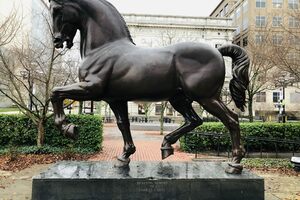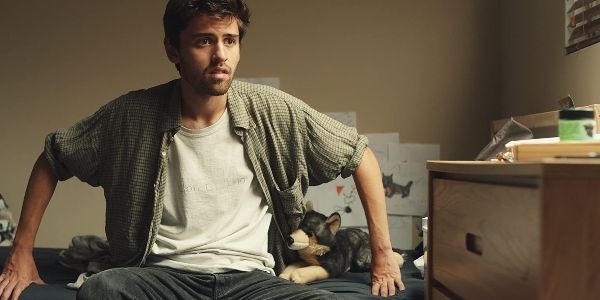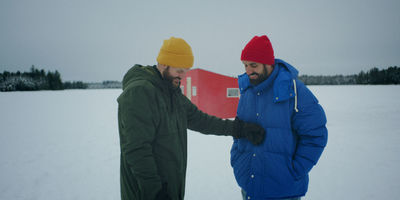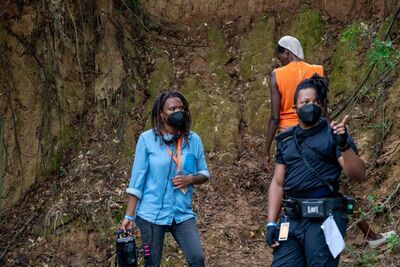Strong Ideas, Loosely Held: Director Josh Greenbaum on Barb and Star Go to Vista Del Mar
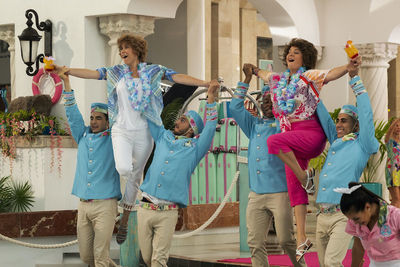
A mouse orchestra. A crab giving advice on love. A boy who sings along to Barbra Streisand and Barry Gibb as he delivers newspapers. Big musical numbers. Candy-colored oceanside architecture. Jamie Dornan. A screenplay by stars Kristen Wiig and Annie Mumolo, who play two irrepressibly cheerful best friends who wander through it all. Josh Greenbaum is the director who brought all of this together in “Barb and Star Go to Vista Del Mar,” and kept it all as delightfully bubbly as a glass of champagne. In an interview, Greenbaum talked about the wisdom and courage behind cheerfulness, casting Dornan in a comedy, and where Barb and Star might go in a sequel.
I’m going to do my best to avoid spoilers here. So just tell me about Barb and Star. Who are they? And what are they like?
Barb and Star are best friends who live in the small town of Soft Rock, Nebraska, which is one of my favorite fictional titles of a town. And, by the way, if you look at one of the scenes where they’re walking in town, you can see that there’s a sign for a Soft Rock music festival. So, Soft Rock, soft rock music, little joke for those paying attention.
That could be the sequel.
Exactly! Actually, the sequel we’ve pitched is Barb and Star Go Very Far to Mars. Anyway, they’re these wonderful best friends who live in a small town and the first time they leave their town is to go on this vacation to Vista Del Mar. And I think as we meet them early on, they feel as though their lives are quite full and fulfilled. But clearly, there’s something lacking and their lives need to be shaken up a bit.
It has a coming-of-age arc as a film. But coming-of-middle-age. We usually associate those coming-of-age stories with teenage years. But in many ways, there’s that element here. But at the core, it’s really about their friendship, and I love them. I would like to go on my vacations with them.
I think we have a tendency to discount cheerful people, thinking maybe they’re not smart, they’re not aware. But cheerfulness is necessarily a bad thing. It’s a wonderful energy to be around.
I couldn’t agree with you more. It permeates the film in a way, and it sets the tone. Barb’s and Star’s personas permeate the film, and there’s an optimism and a sweetness to it. One of the things I love about the film is it doesn’t take itself too seriously. In many ways, it’s feels like a return to silliness in a comedy, which I’m excited to help usher back in. I grew up on John Hughes and then fell in love with what Judd Apatow has done. But a lot of that was more in the dramedy space. And this is a return to fun and comedy with a capital C.
Not only are people discounted for being cheerful, but I actually think cheerful films in many ways parallel that and are underestimated as well. If it’s fun or silly, they’re not taken seriously. But they can be just as impactful on our culture, and our global perspective. I think films and art do influence culture. And I think a movie like this, that at its core is quite fun and optimistic and sweet I’m hoping will help return a bit of our world’s smile back even though we’re all going through something very difficult together.

Tell me how you came to the project.
I made a documentary called “Becoming Bond.” I had a screening of it and I didn’t know at the time but Kristen Wiig was in the audience. And so was Jessica Elbaum, our producer of “Barb and Star.” And the film ended and then I discovered Kristen was there and was a bit star-struck, and she walked right up to me and said, “Oh, my God, I love this film and we need to work together.” Which to me was like, “Oh, this must just be what happens in Hollywood.” But just a few days later I get a call setting up a lunch to meet with Kristen and we had this incredible two-and-a-half-hour lunch, where she proceeded to basically pitch the entire movie to me. She had already written it with Annie, but she pitched it almost beat for beat, acting out all the roles, and it was one of my favorite lunches I’ve ever had in my life, as you might imagine. And I just was like, “Look, I am 100 percent in obviously, and if the script is even half as good as what you just pitched me, I’m so thrilled to be part of it.” And she sent over the script and the rest was history. I came on board and met Annie, who I was less familiar with, but now I’m so blown away by her talent. And we became a little three amigos trio and worked on the script for about a year and then went off and shot it.
That huge dance number is really remarkable, a throwback to classic movie musicals.
It was huge. As a director, I’m always very excited by things that scare me. Right? And I am a huge fan of those Busby Berkeley numbers from way back when. And I saw the opportunity to do them in this film in an organic way and really surprise you. At that point, in the movie, I don’t think we’ve hinted that there’s going to be a giant musical number all of a sudden.
It was so much fun. We had 100 dancers and brought on an incredible choreographer, and Kristen and Annie wrote the music. And it was a blast. That musical number we shot over the course of our entire production because there’s lots of little pieces to it. But those big dance sequences were just so fun. And, of course, bringing on our incredible production designer, Steve Saklad, who gave the whole world its color, and its look, and had us lean into turquoise and magenta. And then our incredible DP, Toby Oliver, who is maybe not an obvious choice, at first, given that his big movie prior was “Get Out.” But he is incredibly talented with the camera. And I wanted the film to feel cinematic. I do think there’s a trap a lot of studio comedies fall into where so much energy and emphasis is put on just simply the jokes, which is obviously what we’re there for, and the dialogue, but I really wanted to lean on that other important arm of filmmaking, the actual cinema, and the camera and the look of it all. And so, the combination of our choreographer and costume designer, Trayce Gigi Field, and just putting together an amazing team enabled a first-time feature director like myself to be able to pull off a huge musical number in a way that I’m really proud of them and hope audiences enjoy.

I have to ask you about picking Jamie Dornan, who is not an obvious go-to for comedy.
Well, it’s a good question. The short answer is, I Skyped with him and we had an hour and a half or two-hour call. What I like to do weirdly with actors is just kind of watch them in interviews. The more I watched him on talk shows, I was just like, “God, this guy’s funny.” Like, he gets it. Obviously, another great test is to see if they’ve ever hosted SNL because you sort of see very quickly what they can do.
We always envisioned putting a dramatic actor in the role and surprising the audience—”Oh my gosh, this guy can be funny.” And I instantly hit it off with Jamie again, he just got it. After while we were making the film, I met his wife and she said, “This is more Jamie. These are the kind of films he loves and wants to make. He just happened to get a really big role early on where he was a serial killer and the rest is history.”
What he did so well, the most important thing for any any dramatic actor who’s trying to explore their comedic chops is, he committed. And I think you see that certainly in his two-and-a-half-minute musical number, the emotional dance on the beach. But you have to play it straight. Your character doesn’t think what they’re going through is funny. It just happens to be the circumstances around them make it funny. And he did such a great job of that. And I’m thrilled for the world to discover this very different side of Jamie Dornan because he’s such a talent. He, by the way, sings in all those as well. He’s got a wonderful voice
What is the best advice you ever got about directing?
Here’s my favorite quote: “Strong ideas, loosely held.” So, you should have a really strong take and have a plan and an opinion on what you want and how you want it done. But then you need to hold onto that loosely because if you’re a smart director, you surround yourself with incredibly talented people, be it costume designers, production designer, DP’s, actors. And everyone is going to have ideas and they’re often going to be additive and be better and you have to be able to let go of your idea and go with “the best idea wins.”
But I think on the flip side if you don’t have a strong idea, now the ship is rudderless. One of my favorite compliments I ever got was when we wrapped Jamie Dornan said, “Thank you—you beautifully captained the craziest f**king ship in the ocean.” It’s a crazy kind of movie where our tone is very sort of specific and tricky. And we’re bouncing around between heartfelt moments and very silly moments. That’s a balancing act. And I think that’s where having a strong idea is important. So, you’re leading everyone in the same direction. But you put up a couple guardrails and let everybody play in between those two guardrails and it’s your job to say like, “Alright, hey, we’ve gone past the guard rails, everyone bring it back,” but let everybody play. Because when you do that I think great creativity, and certainly, in this case, comedy comes out of it.
